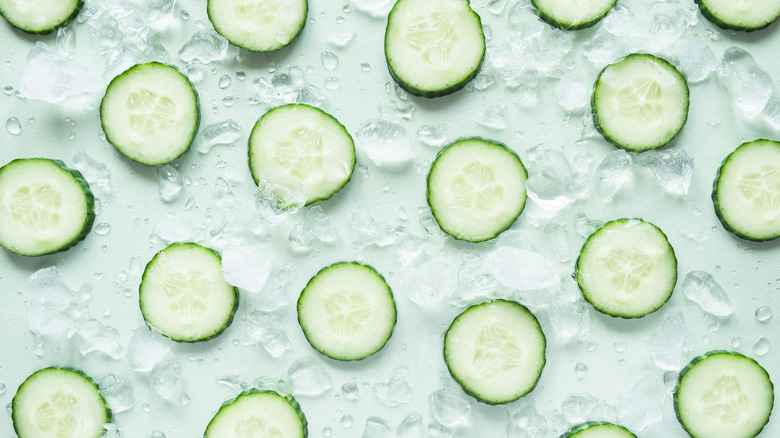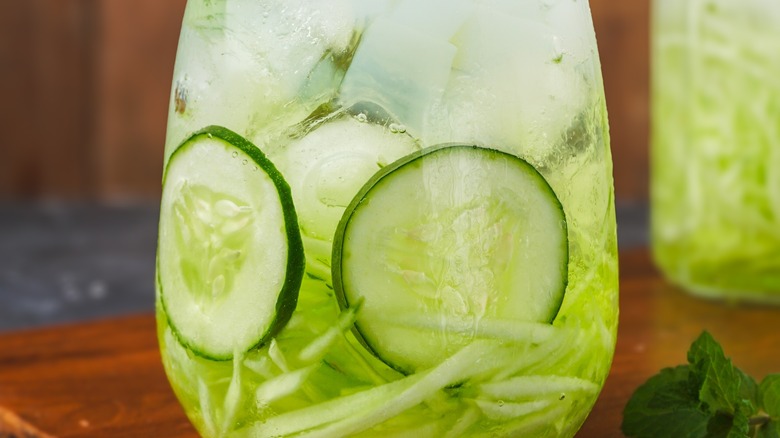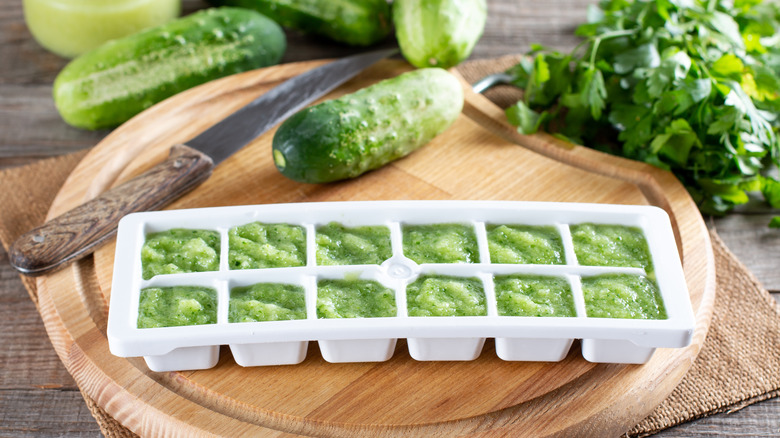Parchment Paper Is The Key To Properly Freezing Sliced Cucumbers
Made up of about 95% water, you'd be forgiven for thinking that cucumbers won't freeze well. However, it's not only possible to freeze cucumbers, but — so long as you prepare them properly — they should hold up pretty well to freezing for a long time. If you end up with more cucumbers in your fridge than you can shake a stick (or cucumber) at, freezing is a great option that allows you to store them for a long time without them getting bendy and shriveled.
To store frozen cucumber like a pro, there's one technique that delivers the best results — slicing and freezing them on parchment paper. This method stops your frozen cucumber slices from sticking, keeps them in the best possible condition, and extends their frozen shelf life to up to nine months. And, best of all, it's very simple.
First, wash your cucumbers (store-bought cucumbers usually have a wax coating, so you may want to scrub this off — although it's perfectly safe to eat). Then, slice your cucumber into ¼ to ½ inch discs and dry the slices thoroughly to prevent ice crystals forming (this can lead to freezer burn). Place the slices on top of parchment paper on a tray, and put this in your freezer. The magic of parchment paper is that its non-stick coating prevents water molecules in the cucumber from sticking to it when they freeze to ice.
Making the most of perfectly frozen sliced cucumber
If you're worried about the space this method of freezing cucumbers will take up in your freezer, just remember that you only need them to be on the tray for as long as it takes for them to initially freeze. After this, you can remove the tray and parchment paper and store the slices in your freezer in a more efficient way, such as using an airtight container or a ziplock bag. Since they've already frozen, there's no risk of them sticking together, as this requires water in liquid form to connect the slices. So, it's easy to grab just what you need without the hassle of having to pull apart the frozen pieces.
Frozen cucumber slices are particularly useful for drinks. You can throw a handful of frozen cucumber slices into a smoothie for added color and nutrition, with the added benefit of cooling your drink. Once everything is blended, you'll have a cold smoothie that's ready to drink right away. Similarly, you can add a couple of frozen cucumber slices to a glass of water, or even a gin and tonic, for the combined benefit of their fresh flavor and ice-like cooling effect. You could even try making a frozen cucumber mint mojito, either added whole like a garnish or blended with everything else to maximize the cucumber flavor.
Other ways you can freeze cucumber
If you really don't have the room for the parchment method, then there are a few alternative methods for freezing cucumbers. Each has its advantages and disadvantages, and some methods are better for certain uses than others. The almost zero-effort option is to freeze cucumbers whole or halved. This isn't advisable as they tend to get limp and mushy once they've thawed, but it's definitely a viable option if you're planning on putting your frozen cucumber to cosmetic use in your skincare routine. To reduce puffiness in the mornings and help you feel more awake and refreshed, rub the sliced end of a frozen cucumber against your cheeks and under your eyes. Once you've finished using it, return it to the freezer, making sure to wrap it well with plastic film to prevent it from coming into contact with other items in your freezer.
Another option is pureeing your cucumber before freezing. Add a little water before blending so the puree isn't too thick, then pour into a container (with space for it to expand when it freezes), or into ice cube molds for on-demand cucumber ice. Pureed, they're a perfect addition to a frozen gin and tonic to cool down on a Summer's day. Although the best method for freezing cucumber slices is with parchment paper, there's no way to avoid them losing most of their crunch when defrosted. For this reason, their best uses are in beverages or recipes where their texture isn't important, like a green cucumber gazpacho.


